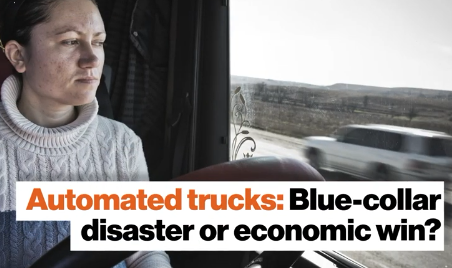The big misconception about the impact of technology in the workforce is thinking that it's around the corner.
关于科技对劳动力的影响,人们有一个很大的误解,那就是认为它即将来临。
Instead it's been with us for years.
相反,它已经存在很多年了。
If you look at the last 20 years or so, we've automated away 4 million manufacturing jobs in Michigan, Ohio, Pennsylvania, Wisconsin, Missouri, Iowa,
回顾过去20年左右的时间,你会发现我们已经在密歇根、俄亥俄、宾夕法尼亚、威斯康辛、密苏里、爱荷华州,
all the swing states that Donald Trump needed to win in 2016 and did win.
所有唐纳德·特朗普在2016年需要获胜也确实获胜了的摇摆州,因为自动化减少了400万个制造业岗位。
Then my friends in Silicon Valley and my friends who work in technology know that what we did to the manufacturing workers
我在硅谷的朋友和技术领域的朋友知道我们对制造业工人所做的事,
we are now going to do to the retail workers, the call center workers, the fast food workers, the truck drivers,
随着经济的发展,以后我们还会以同样的方式对待零售工人、呼叫中心员工、快餐工人、卡车司机,
and then even bookkeepers, accountants, insurance agents, lawyers, and on and on through the economy.
甚至是簿记员、会计师、保险代理、律师等等。
So what happened to the manufacturing worker is a very clear sign of what's going to happen to these other workers moving forward.
因此,制造业工人的际遇释放出非常明显的信号,预示着其他工人在未来会面临什么。
And I talked a little bit about retail workers, the most common occupation in the economy.
我提到了零售工人,这是经济中最常见的职业。
Thirty percent of Main Street stores and malls are going to close in the next five years because Amazon is soaking up $20 billion of commerce every year.
未来五年内,主街上30%的商店和购物中心将关闭,因为亚马逊每年要吸收200亿美元的商业收入。
And many of these workers are making $11 to $12 an hour and don't have a huge savings cushion to be able to make meaningful adjustments.
这些工人中很多人的时薪是11到12美元,他们没有足够的积蓄来进行有意义的调整。

Being a truck driver is the most common job in 29 states.
在29个州,卡车司机是最常见的工作。
There are 3 and 1/2 million truck drivers in this country, average age 49, 94% male, average education high school or one year of college.
美国有350万名卡车司机,平均年龄49岁,94%是男性,平均高中或大学学历。
They're making about $46,000 a year right now.
他们现在的年收入大约是46000美元。
It's one of the higher paying blue collar jobs in this country.
这是这个国家薪水较高的蓝领工作之一。
And on the west coast, you have my friends in Silicon Valley who are trying to automate truck driving.
在西海岸,我在硅谷的朋友正在尝试自动驾驶卡车。
And the reason they're doing that is because of the money -- $168 billion in financial incentives for automating away truck drivers.
他们这样做是因为钱——1680亿美元的财政激励,只为用自动化替代卡车司机。
And that's not just labor savings.
这不仅仅是节省劳动力。
That's also equipment utilization because a truck never needs to stop whereas human-driven trucks have to stop every 14 hours;
这也关乎设备利用率,因为卡车永远不需要停车,而人力驾驶的卡车必须每14小时停车一次;
fuel efficiency because trucks can convoy together in lower wind resistance and so robot trucks would be able get places with less fuel, fewer accidents
燃料效率,因为卡车可以在较低的风阻下一起运货,这样机器人卡车可以用更少的燃料和更低的事故率到达目的地,
because truck drivers right now kill about 4,000 other motorists a year in accidents and that number would come down if you had automated freight.
因为目前卡车司机每年会导致4000名其他汽车司机死亡,如果有自动运货,这个数字就会下降。
So there's a very, very powerful set of incentives to try and automate truck driving as an occupation.
因此,有一系列很强大的激励机制,鼓励人们把卡车驾驶自动化作为一种职业。
Again, though, you have these 3 and 1/2 million truckers, and only 13% of them are unionized.
然而,在这350万卡车司机中,只有13%的人加入了工会。
So there's not going to be a grand negotiation.
所以不会出现大型谈判。
So imagine being a trucker who's taken out $50,000, $60,000 loan to lease your truck and it's your livelihood and your means of support,
想象一下,作为一名卡车司机,你拿出五六万美元去租一辆卡车,这是你的生计和生存手段,
and then all of a sudden, you have to compete with a robot truck that doesn't need to sleep.
然后突然之间,你不得不和一辆无需睡觉的机器人卡车竞争。
And that is what is around the corner for hundreds of thousands of truckers in this country in the next five to 10 years when robot trucks start to hit our highways.
这就是在未来5到10年内,当机器人卡车开始出现在我们的高速公路上时,这个国家成千上万的卡车司机即将面临的境况。
And Amazon is testing out robot trucks as we speak, right now in the Midwest.
现在,亚马逊正在中西部测试机器人卡车。











